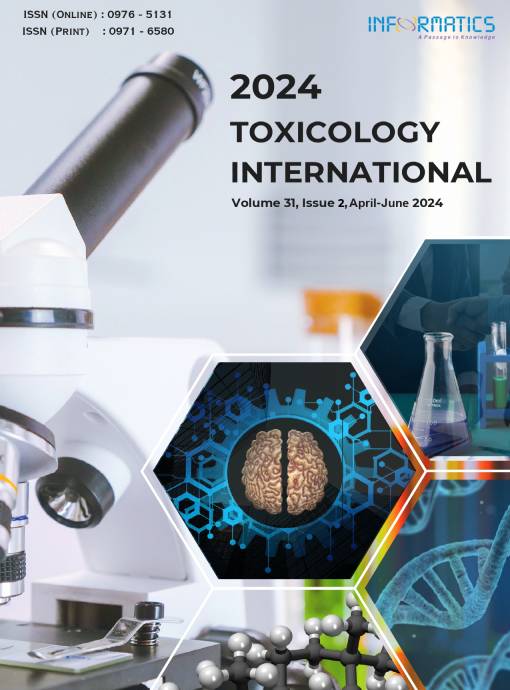Proteolytic Profile Alterations as One of the Scorpion’s Leiurus macroctenus Envenomation Effects on Kidneys
DOI:
https://doi.org/10.18311/ti/2024/v31i2/35384Keywords:
Envenomation, Enzymes, Kidneys, Proteolytic Activity, ScorpionAbstract
Scorpion envenomation becomes a serious challenge for the healthcare systems in tropical and subtropical regions. Among the variety of organs being affected by the venom, kidneys can accumulate most of the toxins recently after the sting, therefore, the homeostasis, including the proteolytic homeostasis of the renal system during the envenomation is under question. Using the SDS-PAGE and zymography methods we have investigated the proteolytic profile in the rats’ kidneys during the Leiurus macroctenus scorpion envenomation. As it turned out, envenomation leads to the increase of the relative activity of enzymes with collagenolytic, gelatinolytic and fibrinogenolytic properties with molecular weights of 30-50 kDa and 50-70 kDa, simultaneously decreasing the relative activity of proteases with higher molecular weight (70-100 kDa). We have also observed the major changes occurring in 24 hours after the envenomation. We may assume that the obtained results are most likely related either to the formation of proteolytically active fragments of proteases with higher mass, or the excessive expression of proteases with lower mass, yet additional tests need to be conducted to prove these hypotheses. Significant changes in assessed parameters in 24h after the envenomation suggest the increased danger in this period of envenomation for the proteolytic homeostasis in kidneys and the integrity of the renal system overall. Therefore, the described effects can be an important reason for the kidney dysfunctions during the Leiurus macroctenus envenomation.
Downloads
Published
How to Cite
Issue
Section
License
Copyright (c) 2024 Matkivska Ruzhena, Shchypanskyi Serhii, Raksha Nataliia, Vovk Tetiana, Halenova Tetiana, Maievskyi Oleksandr, Savchuk Olexiy, Ostapchenko Liudmyla

This work is licensed under a Creative Commons Attribution 4.0 International License.
Accepted 2024-04-01
Published 2024-04-17
References
Abroug F, Ouanes-Besbes L, Tilouche N, Elatrous S. Scorpion envenomation: state of the art. Intens Care Med. 2020; 46(3):401-10. https://doi.org/10.1007/s00134-020-05924-8 PMid:32125457 DOI: https://doi.org/10.1007/s00134-020-05924-8
Ahmadi S, Knerr JM, Argemi L, Bordon KCF, Pucca MB, Cerni FA, et al. Scorpion venom: Detriments and benefits. Biomedicines. 2020; 8(5):1-31. https://doi. org/10.3390/biomedicines8050118 PMid:32408604 PMCid:PMC7277529 DOI: https://doi.org/10.3390/biomedicines8050118
Jenkins TP, Ahmadi S, Bittenbinder MA, Stewart TK, Akgun DE, Hale M, et al. Terrestrial venomous animals, the envenomings they cause, and treatment perspectives in the Middle East and North Africa. PLOS Neglect Trop D. 2021; 15(12). https://doi.org/10.1371/journal.pntd.0009880 PMid:34855751 PMCid:PMC8638997 DOI: https://doi.org/10.1371/journal.pntd.0009880
Lowe G, Yağmur A, Kovařík F. A review of the genus Leiurus Ehrenberg, 1828 (Scorpiones: Buthidae) with description of four new species from the Arabian Peninsula. Euscorpius. 2014; 191:1-129. https://doi.org/10.18590/euscorpius.2014. vol2014.iss191.1 DOI: https://doi.org/10.18590/euscorpius.2014.vol2014.iss191.1
Alqahtani AR, Badry A. Genetic diversity among different species of the genus Leiurus (Scorpiones: Buthidae) in Saudi Arabia and the Middle East. Saudi J Biol Sci. 2020; 27(12):3348-53. https://doi.org/10.1016/j.sjbs.2020.08.048 PMid:33304141 PMCid:PMC7715040 DOI: https://doi.org/10.1016/j.sjbs.2020.08.048
Gunas V, Maievskyi O, Raksha N, Vovk T, Savchuk O, Shchypanskyi S, et al. The activity of metalloproteases and serine proteases in various organs after Leiurus macroctenus Envenomation. J Toxicol. 2023; 2023:1-8. https://doi.org/10.1155/2023/5262729 PMid:36860404 PMCid:PMC9970711
Gunas V, Maievskyi O, Raksha N, Vovk T, Savchuk O, Shchypanskyi S, et al. Protein and peptide profiles of rats’ organs in scorpion envenomation. Toxicol Rep. 2023; 10:615-20. https://doi.org/10.1016/j.toxrep.2023.05.008 PMid:37234066 PMCid:PMC10208795 DOI: https://doi.org/10.1016/j.toxrep.2023.05.008
Salman MMA, Hammad S. Oxidative stress and some biochemical alterations due to scorpion (Leiurus quinquestriatus) crude venom in rats. Biomed Pharmacoter. 2017; 91:1017-21. https://doi.org/10.1016/j. biopha.2017.04.124 PMid:28525944 DOI: https://doi.org/10.1016/j.biopha.2017.04.124
Omran MAA, Abdel-Rahman MS. Effect of scorpion Leiurus quinquestriatus (H&E) venom on the clinical chemistry parameters of the rat. Toxicol Lett. 1992; 61:99- 109. https://doi.org/10.1016/0378-4274(92)90068-U DOI: https://doi.org/10.1016/0378-4274(92)90068-U
Ozkan O, Filazi A. The determination of acute lethal dose-50 (LD50) levels of venom in mice, was obtained by different methods from scorpions, Androctonus crassicauda (Oliver 1807). Acta Parasitol Turcica. 2004; 28(1):50-3.
Yaqoob R, Tahir M, Arshad M, Naseem S. Optimization of the conditions for maximum recovery of venom from scorpions by electrical stimulation. Pak J Zool. 2016; 48(1):265-9.
Raksha N, Halenova T, Vovk T, Beregova T, Maievska T, Tomchuk V, et al. Isolation and partial characterization of serine proteases from jellyfish of the Antarctic region. J Appl Biol Biotechnol. 2023; 11(2):144-50. https://doi. org/10.7324/JABB.2023.110214 DOI: https://doi.org/10.7324/JABB.2023.110214
Palamarchuk M, Niyazmetov T, Halenova T, Raksha N, Maievskyi O, Dzevulska I, et al. Effect of Vipera berus berus and Vipera berus nikolskii venom on proteolytic balance in the tissue of the adrenal glands and testicles of rats. Biomed. Biotechnol. Res. 2022; 6(4):543-9. https://doi.org/10.4103/bbrj.bbrj_287_22 DOI: https://doi.org/10.4103/bbrj.bbrj_287_22
Palamarchuk M, Bobr A, Mudrak A, Gunas I, Maievskyi O, Samborska I, et al. Proteolytic homeostasis in the tissue of the spleen and the heart of rats injected with the venom of Vipera berus berus and Vipera berus nikolskii. Curr Appl Sci Technol. 2023;23(6). https://doi.org/10.55003/cast.2023.06.23.015 DOI: https://doi.org/10.55003/cast.2023.06.23.015
Gunas V, Maievskyi O, Raksha N, Vovk T, Savchuk O, Shchypanskyi S, et al. The Activity of metalloproteases and serine proteases in various organs after Leiurus macroctenus Envenomation. J Toxicol. 2023; 2023:1-8. https://doi.org/10.1155/2023/5262729 PMid:36860404 PMCid:PMC9970711 DOI: https://doi.org/10.1155/2023/5262729
Viswanathan S, Prabhu C. Scorpion sting nephropathy. NDT Plus. 2011; 4(6):376-82. https://doi.org/10.1093/ ndtplus/sfr148 PMid:25984198 PMCid:PMC4421667 DOI: https://doi.org/10.1093/ndtplus/sfr148
Kusirisin P, da Silva Junior GB, Sitprija V, Srisawat N. Acute kidney injury in the tropics. Nephrology. 2023; 28(1):5-20. https://doi.org/10.1111/nep.14118 PMid:36207807 DOI: https://doi.org/10.1111/nep.14118
Demir F, Troldborg A, Thiel S, Lassé M, Huesgen PF, Tomas NM, et al. Proteolysis and inflammation of the kidney glomerulus. CellTissue Res. 2021; 385(2):489-500. https:// doi.org/10.1007/s00441-021-03433-8 PMid:33864499 PMCid:PMC8052535 DOI: https://doi.org/10.1007/s00441-021-03433-8
Resiere D, Mehdaoui H, Neviere R. Inflammation and oxidative stress in snakebite envenomation: A brief descriptive review and clinical implications. Toxins (Basel). 2022; 14(11):1-13. https://doi.org/10.3390/toxins14110802 PMid:36422976 PMCid:PMC9694585 DOI: https://doi.org/10.3390/toxins14110802
Sifi A, Adi-Bessalem S, Laraba-Djebari F. Involvement of the endothelin receptor type a in the cardiovascular inflammatory response following scorpion envenomation. Toxins (Basel). 2020; 12(6):1-14. https://doi.org/10.3390/ toxins12060389 PMid:32545475 PMCid:PMC7374423 DOI: https://doi.org/10.3390/toxins12060389
Cid-Uribe JI, Veytia-Bucheli JI, Romero-Gutierrez T, Ortiz E, Possani LD. Scorpion venomics: A 2019 overview. Expert Rev Proteomic. 2020; 17(1):67-83. https://doi.org/10.1080/ 14789450.2020.1705158 PMid:31834817 DOI: https://doi.org/10.1080/14789450.2020.1705158
Reis MB, Zoccal KF, Gardinassi LG, Faccioli LH. Scorpion envenomation and inflammation: Beyond neurotoxic effects. Toxicon. 2019; 167:174-9. https://doi.org/10.1016/j. toxicon.2019.06.219 PMid:31228480 DOI: https://doi.org/10.1016/j.toxicon.2019.06.219
 Matkivska Ruzhena
Matkivska Ruzhena







